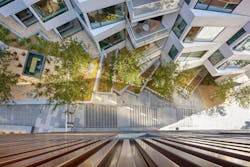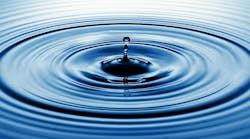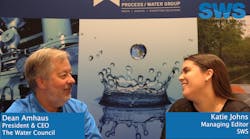Ben Arnold is product manager at Aquacell by PHOENIX Process Equipment Co.
The architecture by award-winning firm Studio Gang, coupled with being located one block away from the Embarcadero with breathtaking views of the San Francisco Bay, made MIRA SF one of the most desirable residential high rises in the city. It did not take long for MIRA SF to become occupied.
Aside from its appeal, MIRA SF, a 392-residence luxury condominium, has one of only two Greywater Recycling Systems permitted to operate by the San Francisco Department of Public Health (SFDPH). The G20R Aquacell system is capable of recycling up to 5,000 gallons per day of grey and rainwater, to be reused for toilet flushing and landscape irrigation.
The Aquacell G20R Greywater & Rainwater Recycling System at MIRA SF is on the shortlist of permitted Greywater Recycling Systems in the city of San Francisco.
How the Recycling System Works
Nearly 1.5 million gallons of potable water will be preserved annually by recycling greywater collected from MIRA's luxury condominiums. Greywater is characterized as wastewater collected from showers, bathtubs and/or hand lavatories. The wastewater collected from kitchen sinks and toilets (a.k.a. blackwater) travels through separate piping out of the building to the municipal sanitary sewer beneath the city streets. Although blackwater recycling for in-building reuse is permissible in San Francisco, it wasn’t suitable for MIRA SF. Greywater in multi-unit residential buildings is plentiful, and sufficient to meet the building’s non-potable demands.
The G20R Aquacell equipment and water collection tanks occupy ~2,000 square feet in the lower levels of the luxury high rise. Greywater is collected and routed to the 4,700 gallon Greywater Buffer Tank. Rainwater collected from the building’s rooftop is stored in a 5,000 gallon cistern. Whenever rainwater is available for treatment, it must be prioritized over grey water. This is a requirement of the SFDPH. This is achieved through the use of level sensors within the tanks and diversion valves on the influent rainwater and grey water piping.
The grey and/or rainwater goes through a series of treatment processes both prescribed and approved by the SFDPH. Those treatment processes include coarse and fine filtration, aerobic biological treatment and disinfection. A water recycling system must also contain processes which meet the requirements defined by the SFDPH for removal or inactivation of pathogens in viruses, protozoa and bacteria.
Maintenance is Key
To maintain a valid operating permit, the water quality must be closely monitored, analyzed and reported. Within the treatment system are critical control points which monitor water quality, such as turbidity and chlorine levels in real time, 24/7. There is also the need for water sample collection and analysis at a certified laboratory. Parameters such as biochemical oxygen demand, total suspended solids and total coliform must be analyzed monthly and reported quarterly. Water quality must always be within the limits established by the SFDPH. If water quality is ever found to be outside the limits, the water recycling system must be taken out of service until proper water quality is restored.
Aquacell by PHOENIX provides service and maintenance of the grey & rainwater recycling system at MIRA SF. The service and maintenance includes periodic on-site labor as well as 24/7 remote monitoring via the internet. The Aquacell system is designed to operate autonomously. On-site labor however is required for tasks such as calibration of instruments, refilling chemical tanks, replacement of consumables, etc. The remote connection to the system enables user to not only monitor the system’s operation but also to perform some maintenance tasks. The remote connection also alerts Aquacell to alarms.
The process by which an alternate water source system is permitted to operate in the city of San Francisco is long and starts well before a drop of water is reused within the building. Prior to an alternate water source system being manufactured, there are a series of steps which must be completed to comply with city regulators. Among those steps is the completion of the Water Budget Application and Calculator.
The Water Budget Calculator is a tool developed by the San Francisco Public Utilities Commission (SFPUC). It is used to calculate the daily and annual volumes of water a building will consume. It separates which fixtures must be supplied with potable water, and which can be supplied with non-potable recycled water. The city’s non-potable ordinance states that all toilet and urinal flushing and irrigation demands shall be met with recycled rain and greywater. Through the use of the SFPUC’s Water Balance Calculator, it was determined that all of MIRA SF’s flushing and irrigation demands could be met with recycled grey and rainwater.
SFDPH requires the development and submission of an Engineering Report document for review and approval. The Engineering Report highlights the details of the alternate water source system. SFPUC’s review of the Engineering Report is the way in which they verify that the required treatment processes are included, and that the specified water quality will be achieved.
Once the Water Balance Calculator and Application have been approved, manufacturing of the alternate water source system may commence. The Aquacell G20R system was manufactured and delivered to site on what is referred to as a “skid.” The skid arrives plumbed and wired to minimize on-site installation labor. There was labor required on site to connect the plumbing and electrical wiring from the building to the Aquacell skid.
Before an alternate water source system may be commissioned for continuous operation, there must be a reliable source of wastewater. In a residential building, there must be sufficient occupancy, producing greywater to be recycled.
Immediately following commissioning, the system must complete a 90-day Conditional Startup Period. During this time, the Alternate Water Source System is fully operational, however all recycled water is discharged to the sanitary sewer. During this 90-day period, the water sample analysis required by the SFDPH is increased. The system must prove that it can consistently produce recycled water quality within SFDPH specified limits in order to receive a final operating permit. Only upon receipt of the Final operating permit may a building begin reusing the recycled water within the building. MIRA SF received its final operating permit on October 19, 2021. The building has been reusing recycled Greywater ever since.
Conserving Fresh Water
As the human population around the globe and particularly in drought prone regions like California, continues to increase, the need to conserve fresh water will remain. On-site water recycling and reuse can have a positive impact on freshwater supplies ensuring there is plenty for all. MIRA SF and the San Francisco Public Utilities Commission are leading the way and showing how sensible use and reuse of precious resources, like water, are the new standard and the way of the future.






